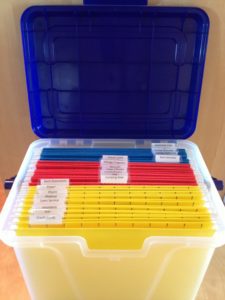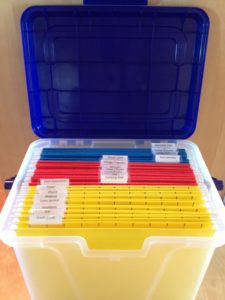What’s the best filing system? Short answer . . . “it depends.”
A filing system is just a way to control how paper, or information, is stored so that when you need the document or data, it can easily be retrieved. That sounds pretty simple, doesn’t it? Easier said than done in most circumstances. If you are looking for the perfect filing system, you need to ask yourself some very important questions:
- Who will be using the system? Will is just be you or will others need access and understanding of the system?
- Will documents be in paper or electronic format?
- How much space will you need for your filing system?
- Where will the files be kept?
- How do you want to designate personal vs. business files?
1. If you are the only one that will use the filing system, you can do pretty much whatever makes sense to you. If you want to file by color, then file by color. If you want to file by date, then file by date. If you want to “file” in plastic totes, go for it. However, if the filing system will be shared with other people, it’s important to ensure all the stakeholders have input into the system. Taking stakeholder input into the design of the system will ensure understanding and buy-in with all parties.
2. If the documents are going to be stored in paper format, make sure only relevant paper is retained. Much of the time when paper documents (bills, insurance renewals, etc.) are received in the mail, there are inconsequential documents that come along with them. Be sure to discard any non-essential paperwork and don’t jamb up the filing system with things that are not needed to support your home or business.
If you are filing electronically, make sure there is a universally understood naming convention that everyone adheres to. For example, your September Comcast bill may be named “2014.09 Comcast” vs “September Comcast bill.” Using a naming convention that includes the year and month will make document searches much easier.
No matter what format the records are retained in, it’s important that appropriate record retention and purging guidelines be adhered to. It’s best to check with your accountant to ensure understanding of record retention guidelines to support your personal or business tax situation.
3. Make sure you have enough space for your filing system so drawers do not become so packed that they can not be used effectively. Filing drawers should only be 70% – 80% full, allowing for ease of movement within the drawers. Using hanging folders will also make a filing system much easier to use.
4. Ensure that your filing system is located where all stakeholders can easily access it. If it’s too far away from the frequent users, information will not get filed in a timely basis, resulting in lost productivity.
5. If you manage files for both a home and business, make sure the files are not mixed together. For example, even though it may make sense to keep a tax receipts together, when it comes time to do your taxes, you will be glad you didn’t. That holds true for utility bills, car expenses, real estate documents, etc. Your accountant will thank you for keeping your home and business records separate.
I could go on-and-on about filing. What’s the best way? When should it be done? Should files or binders be used? If folders are used, should they be color-coded or plain? Should the tabs be straight-line or staggered? There are lots and lots of ways to file correctly. What it basically boils down to is . . . do what works for you and your team.
Cindy Jobs
Member: National Association of Professional Organizers (NAPO), Seattle Area Chapter President
Certified Premium Member: Institute for Challenging Disorganization (ICD)


